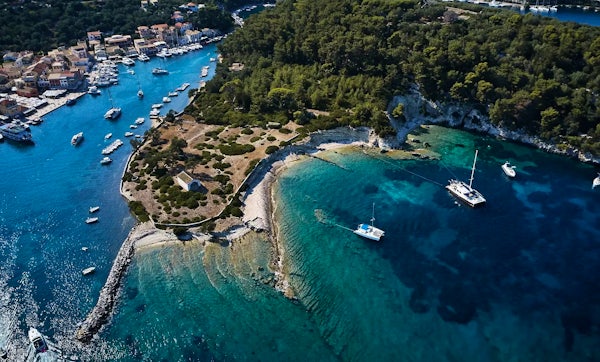Visions of white-sand bays below sheer-cut cliffs, precipitous coastlines that shimmer above a turquoise sea, and hills clad in slender cypresses and olive groves – that's Ionia through and through. Welcome to the westernmost corner of Greece, where the see-through Adriatic Sea becomes the see-through Ionian Sea. Long fabled for its natural beauty, this one's a forever-tempting alternative to the Cyclades region, touting everything from party islands like Zante to laid-back beach destinations like Ithaka.
This ultimate guide to Ionian island hopping can help you plan a trip to this stunning part of Greece. It's got info on the top seasons to travel and some of the most enchanting islands in the chain, along with some practical details about how to arrive in the first place.
Where Are the Ionian Islands?
The Ionian islands are the westernmost isles in Greece. They start at the very end of the Adriatic Sea, just a whisker off the coast of Albania and the Balkan Peninsula. From there, they run for about 160 miles in a roughly south-southeast direction all the way to the side of the Peloponnese. Some – like Corfu – are much closer to Italy than they are to Athens, which lends them a unique character and history.

When to Visit the Ionian Islands?
The Ionian islands aren't just the westernmost in Greece; they are also the northernmost. That has a knock-on effect on the hot season here. It's just a touch shorter than in other parts of the country, and you can find that places like Corfu and Zante are cooling by the start of October in a way that's simply not happening on southerly islands like Rhodes or Crete. Expect daily averages to be around 18 in October and 14 in April – almost two full degrees less than in the Dodecanese.
That said, summers in the Ionian region are very hot. This corner of Greece doesn't get the same brunt of the northerly Meltemi Etesian winds that are felt in the Cyclades, which means breezes to temper the sun aren't that common. It's common, however, for thermometers to hit 40+ in June and August, so be sure to pack the sunscreen. Finally, autumns can bring the risk of Medicane storm systems, which often hit the Ionian isles harder than elsewhere, meaning bouts of heavy, semi-tropical rains are a possibility for late-season holidaymakers.
The top times to visit the Ionian islands for us are:
- Spring (May-April) – This is perfect for hiking on the mountainous isles of Lefkas and Corfu, as temperatures aren't too high and there's less risk of storms.
- Summer (June-July) – Early summer is very hot but doesn't see the same crowds as August. It's the best time to come if you want to top up the tan on the beaches of Zante or Paxi or anywhere else.
The top Ionian Islands
What's an ultimate guide to Ionian island hopping without a look at the best Ionian isles, eh? Not even worth the ancient scroll it's written on if you ask us! Check em' out…
Corfu
Corfu is an absolute stunner of an island. It's a sort of zigzag shape at the top end of the Ionian chain, cut off from the rest by nearly 50 miles of empty sea. But you could spend a whole island-hopping trip here and not get bored. It's home to the bays of Palaiokastritsa, a series of five perfect coves that string along the west coast like a pearl necklace. It's got the rugged Cape Drastis, a symphony of white cliffs that drop to a sky-blue sea. And there are more conventional resort towns with beach apartments and 18-30s bars, around Benitses and Kavos in the south.
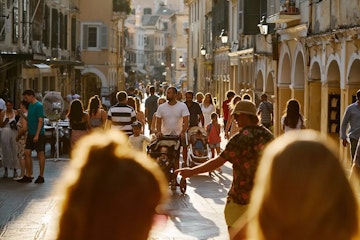
Kefalonia
Made famous by Captain Corelli's Mandolin, Kefalonia has a troubled history as a onetime stronghold of Italian and then German fascist forces in WWII. But that's more than balanced out by the laid-back idyll that you find today. The isle revolves around the fir-covered peak of Mount Enos, which drops to charming fishing towns like Sami. It's one of those islands that's large enough (it's the largest in the whole Ionian region) to feel unbusy even in the height of the summer.
Zakynthos
Zakynthos is probably on the covers of more Greek travel brochures than any other island. The reason? A certain beach called Shipwreck Bay. You've surely seen it…an amphitheatre of chalk-white cliffs above a narrow strip of sand and pebble where the rusting wreck of a 1980 smuggler's ship sits open to the elements. That's really just one of the incredible features on offer, though. You also get to swim with turtles on the south coast and bathe in natural hot springs on the north coast.

Lefkas
Lefkas has the dubious honour of being the only Ionian island that's directly linked to the Greek mainland by a road. On the plus side, that makes it easy to reach for island hoppers who are going by car. On the downside, it means it's a touch busier than other places in the chain and ditches that detached island feel just a little. You won't notice that if you venture into the central valleys though, where time-stood-still villages like Egklouvi and Syvros still beat to an age-old rhythm, offering olive oil farms and craft workshops.
Ithaka
Ithaka inspires a very loyal following that seem to come back year after year after year. We can see why. The island is a compact hit of everything that Ionia stands for – glinting pebble coves, transparent seas, hills clad in pine and fir. It's basically a carless isle, or, at least, you can get anywhere you like on foot with ease. The main port of Vathy is the place to base yourself, as that's where the ferries from other Ionian islands come into dock.
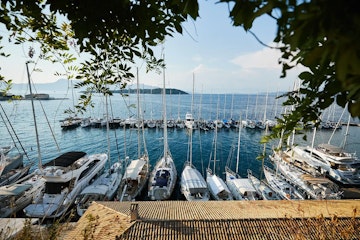
The Top Things to See and Do in the Ionian Islands
This western part of Greece has its own unique array of attractions that anyone planning going Ionian island hopping should really think about adding to the bucket list. Here's a look at just five things that we'd say are 100% unmissable.
Shipwreck Beach, Zakynthos
We've already mentioned this breathtaking jewel of Zante, but we could wax lyrical for hours and hours. There are two ways to see it: By boat from the sea or by land on the clifftop lookout points. If you've got time, we'd recommend doing both. From below, you'll dock up and get to swim under the soaring cliffs. From above, you can snap those all-important Instagram shots of the shimmering Ionian Sea lapping before the shipwreck itself.

Porto Timoni, Corfu
Some say Palaiokastritsa has the better beaches, but we think Porto Timoni tops the list on Corfu. It's a narrow isthmus beach that looks more Thailand than Ionia, with a winding hiking path that will lead you there. Rarely as crowded as other spots on the island, it's perfect for snorkelling, swimming, sunbathing, and a touch of adventure on the side.
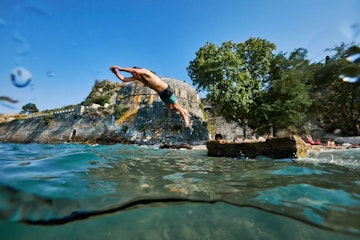
Antipaxos
The tiny pinprick of an island that is Antipaxos sits just south of Paxos, about 15 miles south of Corfu. It can only be reached by a short ferry, a water taxi, or on a private yacht, but the reward is a series of beaches so darn fine you'll have to pinch yourself to check you're not dreaming. Uber-clear waters tinted in perfect turquoise roll against cotton-white sands at Mesovrika Beach and Paralia Vrika on the north coast.
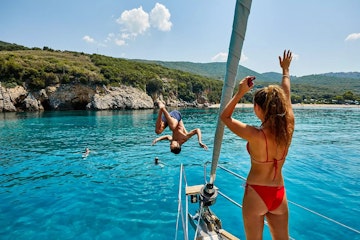
Marathonisi, Zakynthos
Marathonisi is also known as Turtle Island. It's now a protected marine park that encompasses an important breeding ground for rare Loggerhead sea turtles. You might just meet those as you dive off the side of the boat to snorkel through the rock reefs of the Marathonisi Caves. Alternatively, a day's lazing on Marathonisi Beach is sure to please anyone.
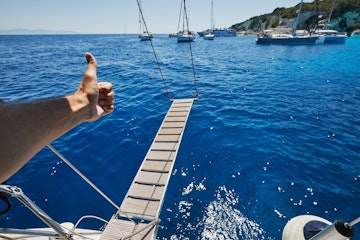
Assos Village, Kefalonia
Talk about charming – Assos Village is one of the best-kept secrets of Kefalonia. It huddles in a picture-perfect harbour with pine-clad hills behind and an old Venetian fortress topping the hills. Within, you'll wander lanes stalked by stray cats and peppered with pastel-coloured cottages, all dropping to a harbour where seafood tavernas sizzle fish cuts on open grills. It's proper Ionia.
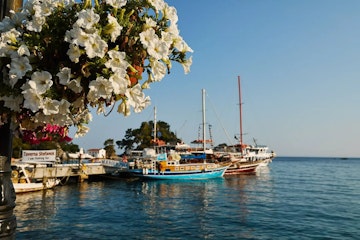
How to Get to the Ionian Islands
Because the Ionian isles are so far from Athens, there are better ways to scoot over to their white-sand bays than going via the Greek capital. Thankfully, there are now quite a few regional airports on the menu, along with some international ferry links that you simply don't get to island chains in the Aegean Sea.
Arrival points from the air include:
- Corfu International Airport – Virtually entirely seasonal save one connection to Athens on Aegean Airlines, this port offers a direct link into the northernmost Ionian isle from big European hubs like Vienna, London, Zurich, and Brussels.
- Aktion International Airport – There are some fantastically priced connections from all over Europe into this airport. It's actually on the mainland in the town of Preveza, but has direct road links to Lefkas.
- Kefalonia International Airport – One of the region's smaller airports but still a great ticket to the stunning island of Kefalonia, a hub of R&R.
- Zakynthos Airport – A fairly busy airport that's got lots of services from TUI Airways and Ryanair, although most run seasonally between May and September.
To find the best deals, you can compare flights on hundreds of sites on KAYAK.
One fantastic alternative to flying is to hop on a cross-Adriatic ferry from Italy. They run most of the high season, from about April to around October time, coming in from ports on the east coast of The Boot (Bari, Brindisi, Ancona, and now even Venice). It's a great option if you'd like to ride a gondola and eat some pizza before starting that Ionian island hopping trip!
Getting Between the Ionian Islands
When it comes to navigating from isle to isle in the Ionian region, things might be a touch trickier than in more conventional island-hopping areas like the Cyclades. It's all a-okay if you have access to your own yacht. Averaging around 5 nautical miles per hour in a 40-footer, you're looking at about half a day's sailing between Corfu and Lefkas. If you don't have your own boat, then you'll be at the mercy of the ferries. Sadly, they aren't the most comprehensive in Greece…
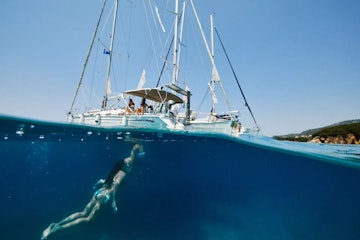
That's mainly because there are very few island-to-island ferries. Instead, connections almost always go via the mainland ports of Igoumenitsa and Patras. So, links from, say, Corfu to Kefalonia are doable, but they'll take considerably longer because there's likely to be a changeover on the way. One way to mitigate that is to choose a string of destinations that are close together for your Ionian island hopping trip – something like Lefkas-Kefalonia-Ithaka, for example.
We hope that this guide to Ionian island hopping has stoked the wanderlust for your upcoming trip to the land of feta and gyros. If you have any questions or just want more inspiration for amazing island-hopping trips in Greece, be sure to get in touch!
